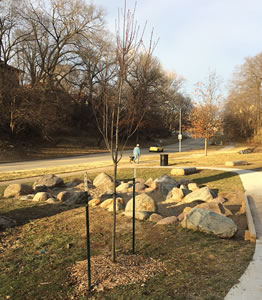New Trees Planted!
New trees are being planted in the park, at the Karnes playground and the sledding hill.
The Karnes playground has been a huge hit for Roanoke Park and its visitors. One complaint that has been heard however is that there can be a lack of shade on sunny days and the equipment can get quite hot. To address that concern, the Roanoke Park Conservancy's playground committee requested this past fall that more trees be planted by the parks department. Rachel Porter, Lance Klein and Chris DeLong worked together to pick the most desirable trees from the city's "contract planting list." Two fast growing and tall trees were chosen for the south side of the playground, where they could provide the most shade in the fewest number of years: a Northern Red Oak, and a Tuliptree (Tulip Poplar). A Sugar Maple was planted not far from the swing set, a Black Tupelo near the "council ring," and a Serviceberry near the boulders and sand. Lance's plan also calls for a White Oak closer to Karnes and a Caddo Maple north of the playground, but those have yet to be planted. Most of these selections are Missouri native trees with high wildlife value and all are handsome trees. We can hear the birds singing already!
Additionally, Lance and Chris requested that more trees be planted to replace those that have fallen or are in declining condition around the "sledding hill" west of Karnes. Two of those have already been planted, both Bur Oaks. North of the small blue swingset, a Bur Oak fell a couple years ago and you can still see the trunk and up-ended roots. Then recently a large White Oak fell not far away, blocking the trail until its rotted trunk was chain sawed out of the way. The trees on either side of the blue swingset are White Oaks that appear to be in decline. Lance and Chris requested that "replacement trees" be planted now near those two. Also requested was a Chinkapin Oak near Karnes, near where the stump is still visible from one of the parks old sentries that came down in 2011-12.
New Trees in the Park
Red Oak, Quercus rubra — 60–90’ tall. Fastest growing oak. Common in Roanoke Park's forest interior, on the middle shelf. Not super long lived (100-125 yrs).
White Oak, Quercus alba — 60-90’ tall. The park needs more of them since our largest ones are not in great health. Wide canopied large trees with deeply divided leaves and large acorns.
Sugar Maple , Acer sacharum 'Legacy'— 40-80’ tall. Dense shade and shallow roots tend to prevent grass from growing beneath them. Gorgeous fall color (see the big one north of Karnes, east of the spring).
"Caddo Maple", Acer sacharum ‘Autumn Splendor’ — 30-60' tall. Very good fall color, drought tolerant.
Tuliptree, Liriodendron tulipifera — 60-90’ tall. Fast growing. Not very valuable to wildlife. Not native to our part of the state but grows well. Attractive blooms.
Black Tupelo, Nyssa sylvatica ‘Afterburner Tupelo’ –– 30-40' tall. Nice shape (pyramidal when young) and glossy leaves. Its native range is only a few counties away. Also called Black Gum or Sour Gum, for the edible, but sour berries.
Serviceberry, Amelanchier laevis ‘JFS-Arb’ — 20-30' tall. Nice white spring flowers, edible berries, fall color. This is a single trunk selection of the east of the Mississippi species, also sold as 'Spring Flurry.' (Our local serviceberry species is Amelanchier arborea. A few exist within the park.)
Trees for the sledding hill include White Oak (detailed above), and...
Bur Oak, Quercus macrocarpa — 60-80’ tall. May be slow growing but grows into a large muscular tree. The twigs, often with corky bark extensions, are thick to support the golf ball sized acorns (largest of all oaks).
Chinkapin Oak, Quercus muhlenbergii — 40-60' tall. Most common oak in the park. Not as tall or fast growing as red oak, but has a beautiful semi-open wide crown and ‘gnarly’ branches. Squirrels go into a feeding frenzy on the acorns and gobble them into bits. Very long lived. (Chinkapins on Blue River Glade near Swope Park have been dated at over 200 years old. The larger ones in Roanoke Park are almost certainly as old.)
